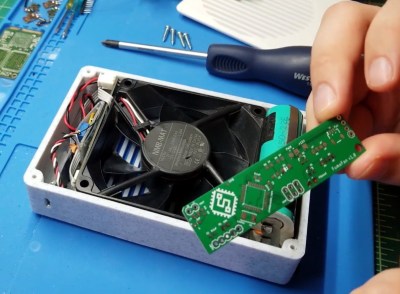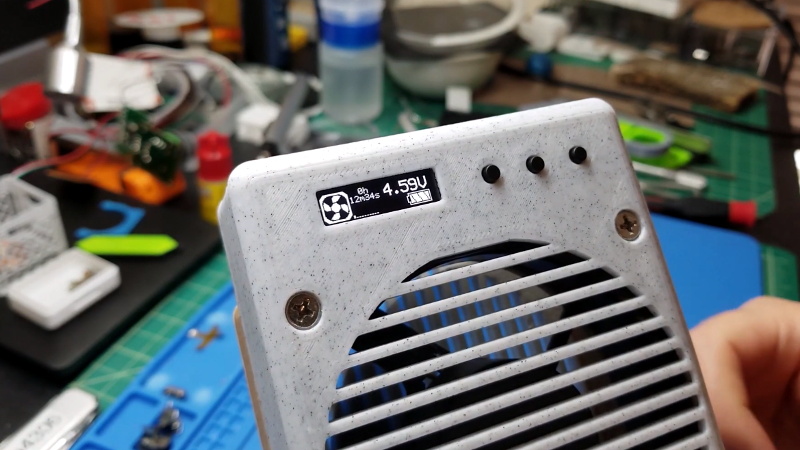Prolific maker [sjm4306] tells us the first iteration of his soldering fan was little more than some cardboard, electrical tape, and a hacked up USB cable. But as we all know, these little projects have a way of evolving over time. Fast forward to today, and his custom fan is a well-polished piece of kit that anyone with a soldering iron would be proud to have on their workbench.
Cardboard has given way to a 3D printed enclosure that holds the fan, electronics, a pair of 18650 cells, and a easily replaceable filter. Between the marbled filament, debossed logo, properly countersunk screw holes, and rounded corners, it’s really hard to overstate how good this case looks. We’ve shamefully produced enough boxy 3D printed enclosures to know that adding all those little details takes time, but the end result really speaks for itself.

The user interface running on the OLED is also an exceptionally nice touch. Sure the fan doesn’t need a graphical display, and [sjm4306] could have saved a lot of time and effort by using a turn-key speed controller, but the push-button configuration complete with graphical indications of fan speed and battery life really give the final product a highly professional feel.
In the video below, [sjm4306] reveals that while the finished product might look great, there were a few bumps in the road. Issues with clearance inside the case made him rethink how things would be wired and mounted, leading to a far more cramped arrangement than he’d anticipated. Part of the problem was that he designed the case first and tried to integrate the electronics later, rather than the other way around; a common pitfall you’d be wise to watch out for.
It’s been proven that, without some external input, solder smoke is going to go right in your face. Whether or not you need to do something this complex is naturally up for debate, but if you want to keep all that nasty stuff out of your lungs, you’d do well to outfit your workbench with some kind of fan.
















I like this, I run a few of my own that I built and only change I would make is to run it off of DC, only because I have it running for like 14 hours a day. I really think that I’m going to try this out. Thanks for the hard work and sharing this.
I prefer a surplus server fan on the other end of a few feet of flex duct. Now the fan can run at quite a high speed without unreasonable noise and it would be easy to direct it out the window or into the bathroom (with the fan running).
The big, BIG problem with this device is that the solder fumes escape into the fan and not into your nose. Shame, really.
Not even an electrostatic precipitator or a active carbon filter? There is room for improvement …
There’s a replaceable active carbon filter in a slot just behind the fan, but an electrostatic precipitator sounds interesting, I’ll have to do some more research into that!
nice build! As for the carbon filter, apparently they are best at filtering odor, if you want to get rid of (possible harmfull) particles, a HEPA filter is the better way to go; see; https://www.sentryair.com/blog/industry-applications/soldering/comparing-solder-fume-extractors-its-all-about-the-filter/
Typical over-engineering :-)
I’d prefer a turn-key speed controller for easy and fast changing speed. However the OLED gives the thing a really nice touch
I have a commercial CNC router with dust collector in my shop that is vented to the outdoors. My soldering area is ducted into that. ( yep, overkill ) This looks handy for field work.